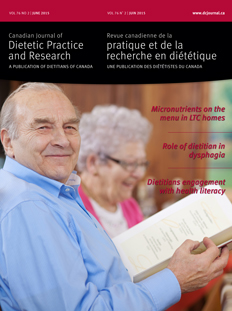Abstract
Purpose: To assess the status of food and nutrition programming in community-based HIV organizations in Canada.
Methods: A telephone survey was administered to 80 community-based HIV organizations asking about characteristics of food and nutrition programs and the perceived program gaps.
Results: The majority of organizations had programs directed at improving food access through meals, food banks, community kitchens or cooking classes, food vouchers, gardens, and street vans. Almost half of the organizations (n = 39) provided nutrition counselling by a registered dietitian or nurse, and the majority also provided referrals to other food and nutrition services in the community. Most organizations would like to have more food-related programming, including: more frequent provision of nutritious and fresh food options, methods to make better use of available food, transportation and grocery vouchers, more staff dedicated to food programs, and improved food preparation and storage infrastructure.
Conclusion: Although community-based HIV organizations provide a range of food and nutrition programs, they face challenges due to inadequate resources. Decision makers should provide more funding for these programs; however, they must be augmented with other supports such as adequate housing, income, and addiction counselling. Dietitians can help organizations maximize the impact of their limited resources and can advocate for systemic changes to enhance determinants of health for people living with HIV.
Résumé
Objectif. Évaluer le statut des programmes d'alimentation et de nutrition d'organismes communautaires canadiens de services liés au VIH.
Méthodes. Une enquête téléphonique a été menée auprès de 80 organismes communautaires liés au VIH au sujet des caractéristiques des programmes d'alimentation et de nutrition et des lacunes perçues relativement à ces programmes.
Résultats. La majorité des organismes offrait des programmes visant à améliorer l'accès aux aliments par l'entremise de repas, de banques d'alimentation, de cuisines communautaires, de cours de cuisine, de bons alimentaires, de jardins et de popotes roulantes. Presque la moitié des organismes (n = 39) proposait des services de counseling en nutrition offerts par une diététiste ou une infirmière, et la majorité fournissait de l'aiguillage vers d'autres services d'alimentation et de nutrition offerts dans la communauté. La plupart des organismes souhaiteraient être en mesure de proposer plus de programmes d'alimentation, notamment : l'offre plus fréquente d'options alimentaires fraîches et nutritives, des méthodes visant à mieux faire usage des aliments disponibles, des bons de transport et d’épicerie, un nombre plus élevé d'employés consacrés à ce type de programmes, l'amélioration de la préparation des aliments et de meilleures infrastructures d'entreposage.
Conclusion. Bien que les organismes communautaires de services liés au VIH offrent un éventail de programmes relatifs à l'alimentation et à la nutrition, ils sont confrontés à de nombreux défis en raison de l'inadéquation de certaines ressources. Les décideurs devraient octroyer davantage de financement pour ces programmes. Toutefois, la hausse des subventions doit être accompagnée d'autres ressources telles que l'accès à un logement convenable, un revenu adéquat et du counseling en toxicomanie. Les diététistes peuvent aider les organismes à optimiser l'impact de leurs ressources limitées et à promouvoir l'adoption de changements systémiques visant à améliorer les déterminants de la santé des personnes vivant avec le VIH/sida.



